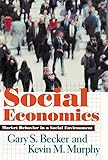Social Economics : Market Behavior in a Social Environment / Kevin M. Murphy, Gary S. Becker.
Material type: TextPublisher: Cambridge, MA : Harvard University Press, [2009]Copyright date: ©2003Description: 1 online resource (190 p.)Content type:
TextPublisher: Cambridge, MA : Harvard University Press, [2009]Copyright date: ©2003Description: 1 online resource (190 p.)Content type: - 9780674020641
- 306.3 21
- HM548 .B43 2000
- online - DeGruyter
| Item type | Current library | Call number | URL | Status | Notes | Barcode | |
|---|---|---|---|---|---|---|---|
 eBook
eBook
|
Biblioteca "Angelicum" Pont. Univ. S.Tommaso d'Aquino Nuvola online | online - DeGruyter (Browse shelf(Opens below)) | Online access | Not for loan (Accesso limitato) | Accesso per gli utenti autorizzati / Access for authorized users | (dgr)9780674020641 |
Frontmatter -- Contents -- Acknowledgments -- Part I. The Effect of Social Capital on Market Behavior -- 1. The Importance of Social Interactions -- 2. Social Forces, Preferences, and Complementarity -- 3. Are Choices “Rational” When Social Capital Is Important? -- Part II. The Formation of Social Capital -- 4. Sorting by Marriage -- 5. Segregation and Integration in Neighborhoods -- 6. The Social Market for the Great Masters and Other Collectibles -- 7. Social Markets and the Escalation of Quality: TheWorld of Veblen Revisited -- 8. Status and Inequality -- Part III Fads, Fashions, and Norms -- 9. Fads and Fashion -- 10. The Formation of Norms and Values -- References / Index -- References -- Author Index -- Subject Index
restricted access online access with authorization star
http://purl.org/coar/access_right/c_16ec
Economists assume that people make choices based on their preferences and their budget constraints. The preferences and values of others play no role in the standard economic model. This feature has been sharply criticized by other social scientists, who believe that the choices people make are also conditioned by social and cultural forces. Economists, meanwhile, are not satisfied with standard sociological and anthropological concepts and explanations because they are not embedded in a testable, analytic framework. In this book, Gary Becker and Kevin Murphy provide such a framework by including the social environment along with standard goods and services in their utility functions. These extended utility functions provide a way of analyzing how changes in the social environment affect people's choices and behaviors. More important, they also provide a way of analyzing how the social environment itself is determined by the interactions of individuals. Using this approach, the authors are able to explain many puzzling phenomena, including patterns of drug use, how love affects marriage patterns, neighborhood segregation, the prices of fine art and other collectibles, the social side of trademarks, the rise and fall of fads and fashions, and the distribution of income and status.Table of Contents: Acknowledgments Part I The Effect of Social Capital on Market Behavior 1. The Importance of Social Interactions 2. Social Forces, Preferences, and Complementarity 3. Are Choices "Rational" When Social Capital Is Important? Part II The Formation of Social Capital 4. Sorting by Marriage 5. Segregation and Integration in Neighborhoods 6. The Social Market for the Great Masters and Other Collectibleswith William Landes 7. Social Markets and the Escalation of Quality: The World of Veblen Revisitedwith Edward Glaeser 8. Status and Inequalitywith Iván Werning Part III Fads, Fashions, and Norms 9. Fads and Fashion 10. The Formation of Norms and Values References Author Index Subject Index Reviews of this book: [Becker and Murphy] are pioneers in the quest to extend the boundaries of rational choice theory in economics.They depict human beings not as isolated individuals but as members of society, shaped by social and cultural forces.This book marks another step in bringing economic theory closer to social reality.--David Throsby, Times Literary SupplementReviews of this book: This fascinating short book seeks to advance a 'social economics' field that would tackle such interpersonal issues head-on. It does so by addressing a diverse set of issues that includes social capital, habits and social interactions, sorting and marriage markets, segregation and integration of neighborhoods, escalation in product quality, status and inequality, and the modeling of fashions, norms, and values.--Stephen R. G. Jones, Journal of Economic Literature
Mode of access: Internet via World Wide Web.
In English.
Description based on online resource; title from PDF title page (publisher's Web site, viewed 30. Aug 2021)


